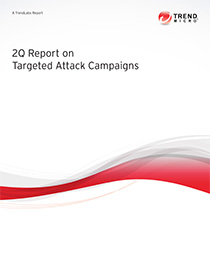2Q 2013 Report on Targeted Attack Campaigns: A Look Into EvilGrab
 View 2Q 2013 Report on Targeted Attack Campaigns
View 2Q 2013 Report on Targeted Attack Campaigns
Highly targeted attacks refer to a category of threats that pertain to intrusions by threat actors or attackers. These attackers aggressively pursue and compromise chosen targets in order to steal sensitive information. These are not conducted through separate attacks; rather, they comprise of a series of attempts over time to get deeper and deeper into a target’s network. Each attempt may either succeed or fail, but the overall goal is to penetrate the target’s network and acquire information. Malware is typically used as an attack vector, but the real threat involves human operators who adapt, adjust, and improve their methods based on the victim’s defenses.
Enterprises should consider targeted attacks a high-priority threat because of the considerable damage they incur. The human and systemic weaknesses that allow an attacker to compromise an organization can be minimized and mitigated with correct practices and solutions. However, these same weaknesses can never be fully resolved.
Trend Micro monitors the targeted attack landscape in order to identify ongoing campaigns and provide additional threat intelligence useful for identifying the existence of these campaigns in an enterprise network. This quarterly report presents the targeted attack campaigns observed and mitigated by Trend Micro based on reported customer cases, as well as our own independently gathered data.
Like it? Add this infographic to your site:
1. Click on the box below. 2. Press Ctrl+A to select all. 3. Press Ctrl+C to copy. 4. Paste the code into your page (Ctrl+V).
Image will appear the same size as you see above.
 Cellular IoT Vulnerabilities: Another Door to Cellular Networks
Cellular IoT Vulnerabilities: Another Door to Cellular Networks AI in the Crosshairs: Understanding and Detecting Attacks on AWS AI Services with Trend Vision One™
AI in the Crosshairs: Understanding and Detecting Attacks on AWS AI Services with Trend Vision One™ Trend 2025 Cyber Risk Report
Trend 2025 Cyber Risk Report CES 2025: A Comprehensive Look at AI Digital Assistants and Their Security Risks
CES 2025: A Comprehensive Look at AI Digital Assistants and Their Security Risks